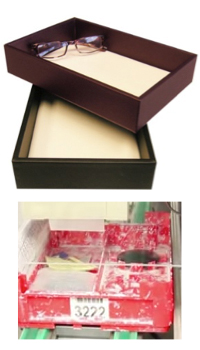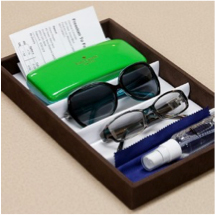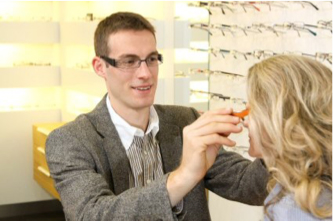The big moment is here: Ms. Jones is picking up her new eyeglasses. She is excited and a little afraid. Excited because these new glasses are so cool. It is the latest style, and she went for the high-tech lenses, too. But, what if she does not like the frame and what if the lenses are not all that great. She has spent so much money. What then? These are the thoughts that go through your patient’s mind and how you present the new eyeglasses is going to play a big role in how your patient will see with the new eyewear.
Remember, seeing happens in the brain. The images formed on the retina are transmitted to the brain via the optic nerve. The interpretation of these signals is what we call vision. How you make your patient feel about the new glasses will influence the visual quality greatly.

It is all in the presentation.
You may choose from a large variety of dispensing trays.
There is only one choice that you cannot make: the old beat up lab tray.
Here are the key points to follow:
1. New eyewear in proper alignment.
Four Point Touch or bench alignment. When the frame is placed on a flat surface upside down, both eye wires and the crest of each temple all rest on the surface. When the frame is turned over, both eye wires and temple tips touch the surface. The temples are parallel, and the frame has a slight face form. There is no X-ing of the eye wires (twisting of the bridge). The lenses are in the same plane and the same height.
Proper frame alignment. When the temples are closed, they overlap and are somewhat parallel with the top of the frame. Nose pads should be symmetrical and have slight frontal, splay and vertical angles.
2. Frame and lenses are clean.
No markings on lenses, no sticky residue on frame, no fingerprints anywhere.
3. Present eyeglasses with the appropriate case
In the case of designer glasses, make sure you have the right case. For all eyewear, hard cases are preferred because they provide better protection.

4. Fit eyeglasses on patient.
Remember, you always put the glasses on the patient and tell them what you do.
“I am putting your new glasses on you. Let’s take a look at the fit on the nose and now I will follow along the temple to check the fit behind your ears.”
Make all the necessary adjustments before you have the patient look in the mirror and admire the new glasses.
5. Invite the patient to view through the new glasses.
Now invite the patient to look around and experience the new glasses.
“Remember that you have your custom designed progressive lenses. Starting out with your distance vision, you will notice a considerable change. Most patients describe it as a wide field of vision. It seems to open up the distance vision. Most patients notice clearer and wider zones for the intermediate and near viewing.”

Again, have your actions match the words. Distance first, then go through the intermediate zones to the reading.
Hopefully, you know your patient’s visual acuity. Be mindful of it. Not everyone achieves great distance vision. Don’t ask them to read the bottom line if you are not sure of their VA.
6. Care instructions and care products.
You will have a cleaning cloth and cleaning solution in the tray. Don’t assume that your patient knows how to take care of their eyeglasses. “As with all your prized possessions, it is important to take care of your new eyeglasses. With a proper cleaning routine and some maintenance, your glasses will give you comfortable, clear vision. Let me tell you how……..” Tell them about the care product you recommend and why it is the greatest. Show them the display, invite them back to purchase their cleaning supplies and have regular maintenance done on their glasses.
Keep in mind that you have an opportunity to build the relationship with your patient each time they visit your office. When they come in to purchase more eyeglass cleaner, you can introduce them to some new product, share a story about the latest development in lens design, or get to know a little bit more about their lifestyle. All of these steps will go a long way in developing loyal patients.

|
Maggie Sayers is a professional development coach and a Master Optician. Her optical career started over 30 years ago in a family business in Germany.
Since she came to Florida in 1987, she has worked diligently to promote high professional standards in opticianry. Her mission is to help opticians achieve their personal success through serving the public as vision experts.
As a professional development coach Maggie provides education workshops that focus on leadership and personal engagement. Her time management course has inspired many participants to think outside the box, apply newly acquired knowledge and achieve extraordinary results.
Maggie's enthusiasm for opticianry is inspiring and her keen business sense paired with excellent communication skills make her a highly sought after motivational speaker.










